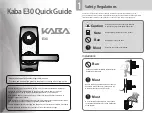
D41G
16
Actuator
Introduction
D41G-A
Mounting of the safety door switch and the actuator
Refer to the D41G actuator's Quick Installation Manual for the corresponding actuator.
The actuator must be permanently fitted to the guard doors and protected against displacement by suitable measures (tamper-proof screws, gluing,
drilling of the screw heads).
Destination and Use
D41G-A2
In conjunction with the safety door switch D41G the actuator is
suitable for hinged and sliding guard doors. The guard door can be
opened and closed from outside by turning the door-handle.
The actuator is pulled into the actuator unit by a spring. The actuator
unit with emergency exit is used to open the guard door inside the
hazardous area. By actuating the emergency exit, the guard door can
be opened from within the hazardous area without the need for
unlocking the safety door switch D41G. The guard door cannot be
locked from inside. On accessible protective equipment, the lockout
tag prevents persons from being inadvertently being trapped. When
entering the hazardous area, each member of the operating or
service team fixes a lock to the lockout tag to prevent the locking of
the guard door and therefore any inadvertent machine start.
Holding force Fzh
- mounting outside 2,000 N
D41G-A1
Actuators D41G-A1 is the preferred choice for use on sliding guard
doors.
Actuator D41G-A1-E0 only suitable for the safety door switch D41G
with concealed installation.
Emergency exit E0 (emergency release tab)
On the actuator with emergency exit, D41G-A1-E0, pulling the
emergency release tab in the direction of arrow (see diagram) unlocks
the D41G safety door switch whereupon the guard system can be
opened.
When the guard door is closed, it is immediately re-locked. The
autonomous, spring-loaded return of the unlocking mechanism, which
is installed by the builder, must be guaranteed.
Emergency
release tab
D41G-A1
@
-E0
Release direction
Summary of Contents for D41G
Page 28: ...MEMO 28...















































